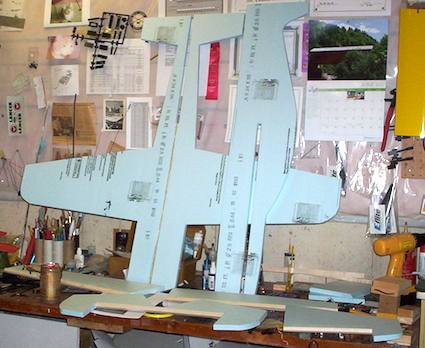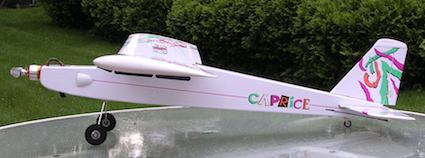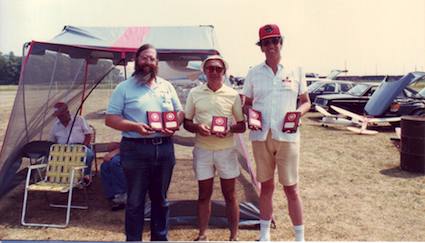 |
Flying High With Electric Power!
The Ampeer ON-LINE!
Fly the Future - Fly Electric! |
Site Table of Contents
| President: | Vice-President: | Secretary/Treasurer: |
| Ken Myers | Richard Utkan | Rick Sawicki |
| 1911 Bradshaw Ct. | 240 Cabinet | 5089 Ledgewood Ct. W. |
| Commerce Twp., MI 48390 | Milford, MI 48381 | Commerce Twp., MI 48382 |
| (248) 669-8124 | (248) 685-1705 | 248.685.7056 |
 | ||
| Board of Directors: | Board of Directors: | Ampeer Editor |
| David Stacer | Arthur Deane | Ken Myers |
| 16575 Brookland Blvd. | 21690 Bedford Dr. | 1911 Bradshaw Ct. |
| Northville, MI 48167 | Northville, MI 48167 | Commerce Twp., MI 48390 |
| 248.924.2324 | 248.348.2058 | 248.669.8124 |
| Mailed Ampeer printed subscriptions are no longer available.
The Ampeer is FREE on-line in Acrobat .pdf format and HTML with active links! | ||
| The Next Meeting:
Date: Saturday, October 13 Time: 10 a.m. Place: Midwest RC Society 7 Mile Rd. Flying Field | ||
| What's In This Issue? | |
| Comment on "Power System for an OK Model Co. Ltd. Pilot PT-19 Kit", Sept. 2012 Ampeer, Cliff Tacie shares how he powered a similar size PT-19 from House of Balsa. |
A 50" Profile Sbach, Art Lane shares the details of his scratch-built, foam version. |
| Electrified Caprice, Nick Bisonni explains how he electrified this glow model from about 1997. | Electric Flexibility Wins Again, Bob Comerford explains how he modified a few planes in his fleet to accept the same 4S "A123" 1100mAh battery packs. |
| Looking for 20-amp Emeter Version 1 Shunt Chris Stoddart is looking for one. | Indoor in London, Ont., Canada, Art Lane provides info on Indoor flying in this area. |
| An Oldie But Goodie! photo of Keith Shaw, Stan Shaw, Udo Fibig, London, Ont. 1988. | Big Spitfire Flies!, Scott Lillis sent along an update on his big Spitfire and link to video. |
| Upcoming Midwest RC Swap Shop Northville, MI, Sunday, Nov. 4, 2012. | "A123" 2300mAh, One Tough Cell, Ken Myers explains why he likes them for their toughness. |
| What Charger Should I Buy? Ken Myers shares his thoughts. | |
|
From Cliff Tacie via email Wow, what a lot of calculation for that PT-19! I've been flying a House of Balsa PT-19, of almost the exact size and weight for a couple of years now. Suggested gas power was a .20 two-stroke. Using a BP Ultimate 2814-6 motor with 11.1V 4400 mAh Li-Po (2 2200's in parallel). (The battery is a 3S2P 2200mAh KM) Prop is APC 10x5E. 45 Amp ESC. Watt meter shows about 450 watts static. (I approximate the amp draw to be a bit over 40 based on the pack, ESC size and the given watts in. KM) Bottom line is, it flies GREAT with this combo. Hope this is helpful. Cliff Tacie House of Balsa PT-19 .25 to .30 Specs:
Pilot PT-19 Specs refresher:
The motor appears to be the The other motor specifications are unknown. Thanks for sharing your information with us Cliff. A 50" Profile Sbach
Good Morning Ken, Nice and informative newsletter again. It looks like I have some studying to do on it though. Boy have you a pile of info there. I was a little worried when I didn't get the newsletter until yesterday, thought maybe you had gone off to fly somewhere, but it's here, many thanks. I've got a new model I'm working on. It is a 50" sBack created out of 4.5mm blue foam. So far, all of the parts have been cut and weighed. It came out at 12.25 oz. That's not to shoddy for such a large ship. I am contemplating using the Thrust 20 on it, with an 11x5.3 prop, that's what I've been using on my Feather merchant, at 6 lb., and it flies great. I'm figuring an all up weight for the Sbach to come out at around, 4.5 to 5 lb. with a 50-mp ESC and 2200mAh 3S Li-Poly. I'm wondering about servos though. I have three GWS Pico, 9g servos that have served me well, in the smaller stuff, but wondered if these were sufficient enough for the biggie. I am using one 1/4" square CF rod for wing strength, and have used 1/2" triangle balsa stock for leading edges on the ailerons, rudder and elevator. It saves trying to cut the foam at the proper angle. I was thinking about spray painting it with Craft paint and figured it would add roughly, two more ounces to the basic weight. That's still not too bad, I think. My only concern is will the Thrust 20 be enough power to fly it. I'm not looking for 3D aerobatics, just up and around and maybe a loop and roll, just lazy flying. Again, thanks for the newsletter, very interesting and Keith looks good. Yak later,
Well, that was very interesting info in the September Ampeer. It was something I should have, or could have, used while building my latest model, a 50" profile Sbach using 1/2" blue foam, carpenters glue and Krylon "Pumpkin" orange paint. The Krylon "Pumpkin" orange paint attacked the foam is several places, making me not too happy.  It is for four channel operation. The model is all done now and waiting for that "Perfect" day to maiden it The model was projected at a weight of 4.5 lb., but with careful selection, and not knowing what I was doing, it came out at 4 lb. with a 4S 2700mAh Li-Poly battery. The motor is the "Sport 46" from HeadsUp RC in Florida and the ESC is the Hextroic 80-amp with a safety switch. So far, only ground tests have been done with my watt meter and it looks line the APC 13x6.5E will be the prop to start with. I have another prop for possible use later. Don't look too closely at the attached photos. It ain't as pretty as I had hoped for, but, it's ready for the maiden flight, hopefully tomorrow, Thursday. 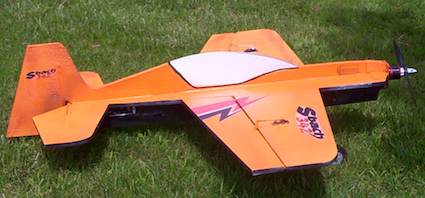 I read through your latest issue of Ampeer and the info I think, is close to what I was looking for. Many thanks for your hard work on the latest issue. Art Well, since we have a day planned for tomorrow, thought I better get out to the field tonight. I did. Success! It flies like a dream, slow and majestically. The wind was 6 mph, still sunny, with the sun behind me. I got the stuff out of the car, carefully this time and installed the Li-Poly a 4S 2700mAh. Charge it read 16.8 volts. I turned on the transmitter, plugged in the Li-Poly, switched on the ESC, and ding ding, beep beep, all was ready using the 13x6.5 prop for this first flight. I taxied out, lined up into what wind there was, and "Goosed" it. Up and away, much to my surprise. It required a couple clicks up on elevator, one click right on rudder, and a click, or two, on right aileron. The flying was great. It flew straight and level with no bad habits.
Back in the pits I replaced the prop with a Master Airscrew 13x8.5 and moved the control rod down, closer to the centre for a little more up, without using the High Rate. I checked the Li-Poly. It still had 15.8 volts in it. I lined up again for takeoff, and surprise, surprise, it took off faster than the first flight. "Good," I said, "now, what will it do?" I flew around for another 7 minutes and low and behold, the ESC went into low voltage mode. I turned around, lined up with the runway, and came down, again, a soft no bounce landing. Am I happy? YOU Wanna bet! The only thing was that I had forgotten the video camera. I left it sitting on my work bench. Oh well, next time, maybe Saturday. The finish voltage on the Li-poly read 12.6V, so, that smart ESC saved the day again. Art Congratulations Art on a nice flying plane and successful maiden! Electrified Caprice
Hi Ken, Continued thanks for your work providing us the excellent Ampeer newsletter. I had one plane left in the "to be built" stock and finally got to work. I purchased the "Caprice ARF" in 1997 from Hobby Shack (now "Hobby - People"). This plane is designed for a 0.15 glow engine. I decided to electrify it. The reviews for this plane noted a tail heavy condition requiring nose weight to balance the CG between 2 1/4" to 2 3/8" aft of the leading edge. Keeping this in mind I moved up the servos as much as possible and designed a battery mounting system by cutting clearance through the engine firewall so that the battery sits as far up front as possible. Velcro secures the battery pack. The CG consequently balanced on spec. without additional weight. All up weight is 40 oz. The plane ROG's and flies very nice at half throttle. The first two flights were 10 and 12 minutes with battery to spare. I figure 15 to 18 minutes when I decide to "empty the tank". All up weight is about 40 oz. The components used/specs are as follows:
Photos showing the conversion details and RCM Review are available here. It is the free public "Photobucket" site. Stay well,
The info for the Caprice in Nick's photo bucket indicates the wing area is 25 dm2 or about 388 sq.in. and has a flying weight of 1150g or about 40.6 oz. as a glow plane. Nick's conversion ended up at about the same weight. Using 388 sq.in. and a RTF wt. of 40 oz.
Nice one Nick! Electric Flexibility Wins Again
Hi Ken, With some months of experience with LiFe cells and brushless motors now under my belt I decided to re-examine some of my original decisions. I was generally happy with most I had made but one was proving troublesome. The decision to make use of the 1100mAh cells as a 3S pack was fine until I decided I needed (wanted?) more power in one or two of my planes. The packs were chosen as suitable for planes using about 100W input and had proven a good choice. Trouble was I now had one plane that really needed about 200W input and another I now wanted to fly at a similar power level. The 4S packs of 2300mAh used for my circa 400W planes were not ideal for the job. Initially I could and did achieve the power levels I required by simply making use of suitable higher Kv motors with the 3S packs, however this came at the expense of motor run time. Flight times proved too short to be acceptable to me. Experimentation with packs, motors and props showed that a little larger fuel tank (4S pack of the 1100mAH cells) would be best suited to my needs. So, given I am not a fan of having special packs for certain planes the decision was made to convert all 1100mAh packs to 4S and adjust the motors and props to suit. Given that I was able to mix and match motors and props from my small collection to achieve suitable results with the 4S 1100mAH packs for those planes needing 200W input there only remained the issue of those I still wanted to run at about 100W. The one that appeared to present the biggest hurdle was a foamie cub I was using for loafing around, touch and goes and some newbie flight training. It was currently running a geared S400 (6V) and a change to one of the lower Kv (7.2V version) motors I still had in stock would have helped with the change to a higher voltage pack. There was however little room for relocation of the heavier battery without major foam surgery to keep the CG where I wanted it. The decision was taken to make the change to a lighter brushless motor. As luck would have it, one of the motors I had in stock proved more than acceptable when bench tested (Turnigy D2830 - 11, 1100Kv) allowing me to keep using the prop that best suited my needs for this plane (Taipan 7x6). The new combination also meant that the stall speed of the plane had not radically changed; another plus. I had purchased a few 30A speed controllers for use with 3S packs. While they were rated as usable with 4S packs of Li-Polys they only had linear BEC circuitry, so I use them very conservatively. Bench testing showed they were not overheating with 4S packs of LiFe cells and 2 or 3 low current analogue servos while running a motor at about 20 amps. I decided to continue utilizing them where possible. When I use anything with higher current drain on the BEC, I will make use of ESCs with switching BEC circuitry such as I already owned for use in my larger planes. 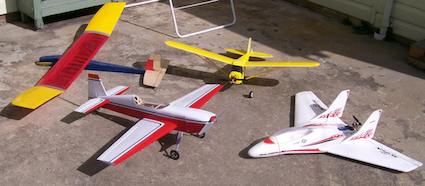 The accompanying photo shows a collection of planes, all with differing missions but able to make use of the same battery packs. I also had need of replacing my last aging Nicad receiver pack, which is used for my gliders and often used in an Amptique, if it was used for thermal searching. I resolved to also use LiFe cells for this application. While I gather some are just using a 2S pack raw I would like to do some testing before subjecting servos to 6.6 Volts. For now I have made an add-on diode extension lead to drop the volts back below the manufacturers recommended 6V max. I am using a 3A diode which is overkill for my current applications. 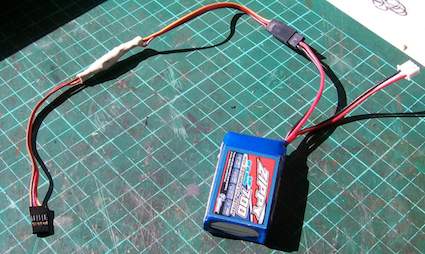 I am still trying to sort the wheat from the chaff when it comes to value for money with 2.4G radio technology, servos, planes, ESCs etc. With the big influence over here on supplies sourced directly from China I am getting a little more confident when asked for advice by newbies. Knowledge gained still seems to take time and money! Hope you are getting in plenty of flying during your summer and congrats on being inducted into the hall of fame. Regards,
Thanks for sharing all of that interesting information with us and thanks for the congrats on the Hall of Fame induction. Also, thanks to the many readers of the Ampeer who sent along congratulations for the Hall of Fame induction. I appreciate it very much! KM Looking for 20-amp Emeter Version 1 Shunt
I enjoyed reading the July 2012 issue of The Ampeer. Your detailed discussion of the difficulties you encountered in obtaining consistent and accurate data related to motor and propeller characterization was very informative. I too am using Drive Calculator and a Hyperion Emeter, in my case to examine some motors to be used in competition free flight models. I am using a Hyperion Emeter v1 with the standard 100 amp shunt supplemented with good quality digital VOM. My task would be easier if I had one of the 20 amp shunts that used to be sold for the Emeter v1. Do you know of anyone that might sell me an old 20 amp shunt? Best Wishes,
If anyone has one for Chris, I've included his email address to contact him. Thanks, Ken. Indoor in London, Ont., Canada
Art sent this to me back in April and it has languished in my 'inbox' since then. With the indoor season approaching, I thought it would be a good idea to include the info here. If you live near these fine folks, join up with them for some fun indoor flying. KM 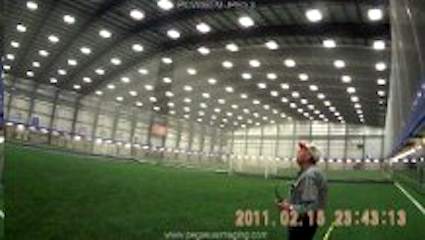 Good morning Ken, Well, another great rag, full of info. We just finished our indoor season with a big bang up indoor event at the new BMO soccer complex, here in London. We rented one field, soccer size, and he threw in the second field for us since this was a test run to see if it's feasible for next winter's program. We had 18 flyers attending and for the two hours we rented, everybody got in a good number of flying times. It looks like a good place for our indoor events, providing we can get the cost down, a little. $150.00 per hour is a little steep, but with him giving us the second field, the guys kinda bit the bullet. We got some pictures but mine were too shaky so forgive me for this, flying indoor at a new place always make me nervous. Frank test flying my new Sbach, scratch built, for its first flights. The others were taken on the HK micro Video camera, of which we are still editing for our club. Again, thanks for another great newsletter. Art 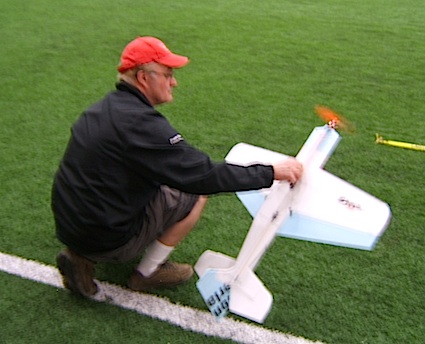 An Oldie But Goodie!
The photo shows, left to right, Keith Shaw, Stan Shaw (no relation) and Udo Fibig with their plaques. The photo was taken in the EXTREMELY HOT summer of 1988 at the Forest City Flyers club field near London, Ont., Canada. It was their first electric event. Yes, that date is correct, 1988! Big Spitfire Flies!
There was a long discussion about a power system for the World Models Giant Scale Spitfire in the April 2012 Ampeer with and update on the power system in the June 2012 Ampeer. Both issues are available via the Complete Ampeer Index at theampeer.org/ampeer/Complete-Ampeer-Index.html.
Finally ready to maiden. I put a watt meter on it tonight and I'm getting 2200 watts in at 60 amps with a 19x10 prop. Currently it has 2 5S 5000mAh batteries wired in series. To you both (the email was sent to two folks KM) a big thanks for helping me with info and such. When I do the maiden I will hopefully get some video. Finally got some video of the new Spitfire. Thanks Mike. www.youtube.com/watch?v=9F6xhgDV3VA 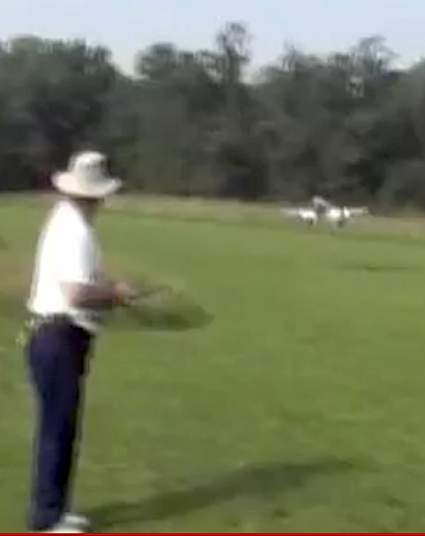 Screen capture from the video. It looks like a winner to me! Check it out folks! KM
Midwest RC Society
Sunday, November 4, 2012
Location
Admission Charge
Vendor Table Cost
For Information call Rudi Reinhard 248-631-8205 or email wwtbi@comcast.net Directions
This is the BEST and LARGEST swap meet in southeastern Michigan! "A123" 2300mAh, One Tough Cell
2011 was not a good year for some of my "A123" 2300mAh cells. My parkzone T-28, which was used as a trainer with a buddy box, went down hard due to a radio failure. The transmitter was shut off "accidentally" during the flight. The plane, most of the electronics and power system were destroyed. That is pretty hard to do with a parkzone T-28! The plane had a 3S "A123" 2300mAh pack onboard. One cell shorted and destroyed itself. There was no fire. The connection braid was burned through. The other two cells survived and were mated to two "new" cells to power a Thunder Tiger Lazy Tiger Cub as the new club trainer. The two 'old' cells and the two 'new' cells played together nicely for the remainder of the flying season. They are still going strong as we approach the end of the 2012 flying season! They are amazing cells! 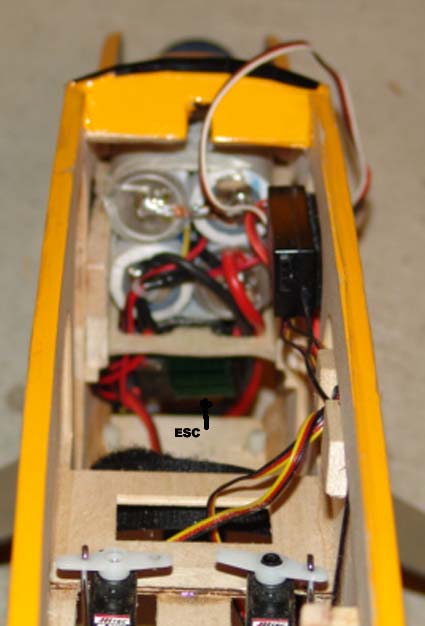
Two of the cells in the 4S pack are from the crashed T-28 On August 26, 2011, my Model Tech Fledgling Gen-II trainer plane was inexplicably lost during a buddy box training flight. I mean really lost. There was no sign of it to be found after a failure to pull out of a diving left turn when I took back the buddy box control. The plane sat in the elements until it was found on October 5, 2011. The carcass and parts sat in the basement until November 4, 2011. The voltage of each cell of the 3S "A123" pack was checked and found to be between 0.2 and 0.3 volts. Not a good sign. 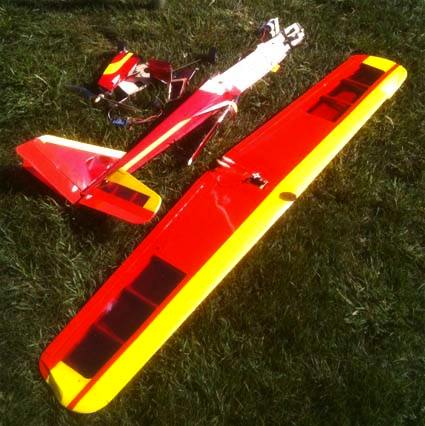 The pack was charged using a SR Batteries Smart Charger, a NiCad/NiMH charger, until each cell reached at least 3 volts. Next it was charged using a CellPro 10S set to "A123" cells at 2.4 amps. Once the pack was charged, it was discharged at 1 amp using the SR Batteries Smart Charger. After discharging, it was charged again using the CellPro 10S at 2.4 amps. After the charge, the charged pack was sat until the next morning. The cell voltages were measured early the next morning and found to be 3.37, 3.38 and 3.39 volts. The CellPro 10S noted the pack capacity at 90% at the start of a "top charge". The pack was charged again using the CellPro 10S. It only took a couple of minutes to "top it off". Only 38mAh were put into the pack by the charger. Later that morning the pack was taken to the field and flown in the Son of Swallow. The first flight was taken using the charge from home. It was a normal flight in every respect. The plane is a 6-minute plane the way I have it propped. The pack was recharged at the field with the CellPro 10S set on "A123" at 10 amps. The plane was flown again and approximately 1700mAh returned when charged after the 6 minute flight. Another flight was taken in the high winds and again about 1750mAh was returned to the pack. The pack was left in its full charged state. Keith Shaw had a parkzone T-28 that he was no longer using as a student trainer plane and gave it to me near the beginning of the summer of 2012. The motor that I had in my T-28 was installed in Keith’s plane and I started using the 'lost' 3S "A123&^quot; 2300mAh pack in it. It was used throughout the summer of 2012 as an alternate club trainer. I also flew it a lot as my windy day flier plane and just because it is fun to fly. One cell is showing signs of weakness and will be replace this winter, but all in all, the "A123" 2300mAh is one tough cell! I guess you can say, "Crash tested tough!" What Charger Should I Buy?
As Head Flight Instructor at the Midwest RC Society and editor of the Ampeer, I am often asked this question. I really do not have an answer. Getting into RC and electric planes is not cheap, but I've seen too many folks, trying to save some money, not get 'enough' charger. In the charger section of my article "Getting Started in Electric Flight: An Introduction and Some BASICS", I did give some general thoughts, examples and ideas. Article at: www.theampeer.org/e-basics/e-basics.htm Charger section at: www.theampeer.org/e-basics/e-basics.htm#CHARGERS "A high power, balancing, multi-chemistry charger with discharge function is the 'best' choice. It should charge and discharge Lithium Polymer (Li-Po/Li-Poly), Li-Ion (Li-Io), Lithium Iron Phosphate (LiFe), NiCad, NiMH, and Pb (lead acid). Decent chargers require an external power source such as a Deep Cycle Marine/RV battery or power supply - NOT a car battery! There are NO decent chargers with a built-in power supply. They are too limited in power to be useful for most purposes. It is very handy to have a charger that will discharge so that a storage charge can be put on Li-Poly batteries when storing for extended periods of time. A storage charge is approximately 3.7v to 4v per cell with most chargers. When set to storage charge, many chargers automatically charge to 3.85v per cell." While it is very possible to argue that chargers with built-in power supplies might be all that some folks will ever need, I've never personally met one yet. At the Midwest RC Society flying field, where I do most of my flying, the vast majority of chargers showing up at the field are the ones from FMA, with most of them being either the CellPro 10S or CellPro 10XP. Whether there are more of them because there are more of them is hard to say. I found your report on the data logging of the Castle Creations Phoenix Ice 50 very interesting. Personally, I have both a CellPro 10S and CellPro 10XP. They are extremely easy to use and reliable. I only use mine with a deep cycle Marine/RV battery, as I use only "A123" 2300mAh cells in my planes and their batteries are always charged before I leave the field. I always leave them fully charged, even through the non-flying season. For those that charge their Li-Poly batteries at home, EFO member, Rick Sawicki, recently purchase a very nice power supply from Radical RC and highly recommends it. The one that he purchase is called the "Doc Brown's 47 Amp 12V Power Supply". Radical RC List several different versions and they are found on the Web site at www.radicalrc.com/category/Power-Supplies-12V-from-110V-46. There are many suppliers that sell the FMA branded chargers. I have been extremely pleased with Progressive RC! I cannot recommend it highly enough. I do not want this article to be mistaken for any type of advertisement for FMA, although it is clearly and endorsement. It is just that a lot of fliers at OUR field have found the 10S and 10XP to be useful and reliable. These are folks who fly everyday electrics right through those that follow the precision aerobatics circuit, with contests every weekend here in middle America. Both Radical RC and Progressive RC are excellent suppliers and should be supported. Both of these suppliers sell chargers that are equal to or better than the FMA chargers noted here. One word of caution, keep the charger simple. While I am a big fan of the FMA chargers, I purchased the excellent PowerLab 8. After reading through the manual, I set the charger aside for a year. I was intimidated by all its functionality. It was way more charger than I wanted or needed or perceived that I would ever need. A year later, after not even hooking it up once, I sold it and purchased a 10XP and haven't looked back. What charger should you buy? It should be powerful and easy to use. Do your research online. It also helps if at least one person where you fly owns one, as they become a handy personal reference. Got questions about the FMA CellPro 10S or 10XP, come on out and visit us at the Midwest RC Society, there'll most likely be a user there. |
To Reach Ken Myers, you can land mail to the address at the top of the page. My E-mail
address is:
kmyersefo@theampeer.org
EFO WEB site: http://www.theampeer.org
